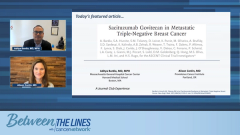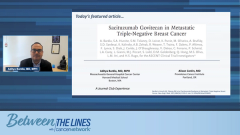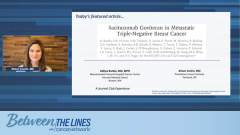
Interpreting Data From ASCENT: Practical Use of Sacituzumab Govitecan in mTNBC
Centering discussion on sacituzumab govitecan use in metastatic triple-negative breast cancer, expert oncologists reflect on results from the phase 3 ASCENT study.
Episodes in this series

Transcript:
Aditya Bardia, MD, MPH: In terms of the summary, the study established sacituzumab govitecan as a treatment option, and the FDA approval is for the second-line and plus setting for patients with metastatic TNBC [triple-negative breast cancer].
Alison Conlin, MD: It showed a great new active agent. It’s something we’d want to give to our patients. I completely agree about the toxicity profile. Those are toxicities we see with chemotherapy, but the grade 3 rates of diarrhea and nausea were low. We can manage those types of toxicities with supportive measures and by telling our patients what to expect.
What do you think about other data that have come out? For instance, some of the data is looking at how important the TROP2 expression is on the tumor in this group of patients.
Aditya Bardia, MD, MPH: When the data were initially presented, it was the primary summary. Over time, we’ve seen subgroup analyses looking at 3 broad themes. One is biomarkers. In terms of looking at TROP2 and outcomes in the ASCENT trial, there are 2 important observations. The first is that the degree of TROP2 expression correlates with the response rate with sacituzumab govitecan. If you purely look at sacituzumab govitecan, tumors that have high expression of TROP2, and the response rate, the progression-free survival [PFS] is higher than that of tumors that have low TROP2.
The next question is, should it be used in clinical practice? The answer is no. Even in the low TROP2 subgroup, the response rate and PFS, while lower than high TROP2, was still better than that of standard chemotherapy. Even in the low TROP2-positive TNBC, the progression-free survival and overall survival response rate with sacituzumab govitecan is better than that of standard chemotherapy. In general, TROP2 is not something that should be used in clinical practice, at least at this time.
The second theme looked at UGT1A1 because the drug has SN38, which is metabolized by UGT1A1. The question was whether polymorphisms or germline polymorphisms in UGT1A1 would correlate with the incidence of adverse effects. You could see some correlation. Some of the adverse effects, like febrile neutropenia, were higher in patients who cannot metabolize irinotecan very well.
The next question is, should it be used in clinical practice? The answer is no. Usually these are adverse effects that you see in the first cycle, and then you can dose-reduce if needed. There could be a patient who has good metabolism of SN38 but could have more adverse effects and vice versa. It takes awhile to get these results, and these are expensive as well. In general, at least in my practice—I’m curious to hear about your practice—we don’t use UGT1A1.
Finally, subgroup analyses. If we look at age, more than 65 years vs less than 65 years; if we look at patients with germline BRCA mutation vs wild-type; or if we look at patients who initially were ER [estrogen receptor]–positive and then became TNBC, in all these subgroups you could see the benefit was higher with sacituzumab govitecan vs standard chemotherapy. For all the subgroups for patients with metastatic TNBC, that’s my second-line regimen. I’m curious to hear your thoughts related to subgroups or UGT1A1.
Alison Conlin, MD: I completely agree. I don’t use that testing in my practice for these patients, although I’m asked frequently by some patients who have learned about the data themselves or read about the agents, so it is good to review where we’re at with that. Similarly, with other ADCs [antibody-drug conjugates] and HER2 [human epidermal growth factor receptor 2] expression, patients frequently ask, “Are we testing my tumor for TROP2 expression?” Your comments on that are well taken. At this time, that’s not the standard of care, but we’ll await future work that may help us learn a little more.
The final subgroup I’ll mention is those patients included in the study who had stable brain metastases. We know that our patients with TNBC frequently get brain metastases, and that’s a very poor prognostic sign for patients in this trial. Patients were included not as part of the primary end point, but a proportion of patients had treated stable brain metastases. In looking at that subgroup, they benefited from sacituzumab govitecan over other choices of chemotherapy. While we’re considering brain metastases as a very high unmet need—we do need more work on those patients with active progressing TNBC in the brain—for now we can feel good that if we locally treat patients with TNBC who have brain metastases, this is a great option for them to control the rest of their systemic disease.
Aditya Bardia, MD, MPH: That’s a great point. Something that can be seen in the TNBC setting is patients with brain metastases.
Transcript edited for clarity.
Newsletter
Stay up to date on recent advances in the multidisciplinary approach to cancer.





















































































